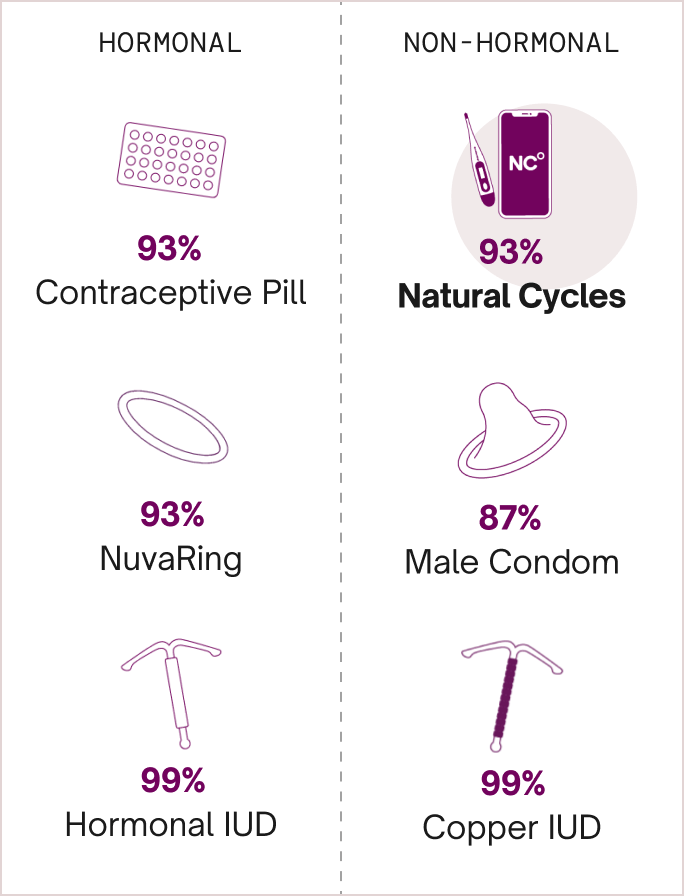How to take birth control pills
Key takeaways:
- Birth control pills are taken orally at the same time each day in order to prevent pregnancy
- Instructions on how to take the pill will vary between brands and types of pill, so you should always check the leaflet that comes with your pill packet or talk to your doctor
- You can take the pill for more reasons than just to prevent pregnancy, for example, to reduce acne or manage bleeding or other cycle symptoms
On this page
- How birth control pills work
- When to use the pill as your primary birth control method
- How to take birth control pills
- How do I use the pill to stop my period?
- When can you start using birth control pills?
- What to do if you miss a pill?
- Stopping birth control pills
- What do I do if I want to get pregnant?
- Take control of your cycle
How birth control pills work
Birth control pills contain synthetic hormones that affect the menstrual cycle in order to prevent pregnancy. The hormones in the pill act in several ways to prevent pregnancy, including: stopping ovulation (the release of an egg cell) and thickening cervical mucus, making it harder for sperm cells to travel through the female reproductive system.
Types of birth control pills
There are two types of birth control pills that are taken daily to prevent pregnancy. These are:
The combined pill: This is the most common type of birth control pill that’s prescribed. It contains a combination of synthetic hormones estrogen and progesterone (known as progestin).
Progestin-only pill: Sometimes called ‘mini pills,’ this birth control method contains only progestin. These types of pills are often prescribed as an alternative to the combined pill, as some individuals can’t take birth control containing estrogen.
When to use the pill as your primary birth control method
There are lots of birth control methods out there, and it’s always a good idea to talk to your doctor about your options before you switch to a new form of contraception. The birth control pill may be a good fit for you if you want to:
- Have penetrative sex without getting pregnant
- Reduce acne (combined pill only)
- Manage severe PMS symptoms
- Regulate your menstrual bleeding
- Reduce symptoms of certain conditions (such as PCOs or endometriosis)
Keep in mind that the pill does not protect against sexually transmitted infections, but you can use a condom alongside the pill if you want to protect against these.
Finding the right birth control method for you will depend on a number of factors, including your lifestyle, personal preferences, and any underlying medical conditions you may have. If you’re looking for a hormone-free method, you have options, including the copper IUD and Natural Cycles, the certified birth control app that's in the same effectiveness category as the pill.

How to take birth control pills
This depends on the type of pill you’re using. The combined pill is often taken for 21 days and is then followed by a 7-day break when either sugar pills or no pills are taken. During the break you’ll experience a light bleeding known as a withdrawal bleed that’s similar to a period. You can also choose to take the combined pill continuously, which some people prefer to do. The progestin-only pill is always taken continuously (without breaks).
Whichever method you’re using, it's advised that you take your pill at roughly the same time each day. Building this into your routine, such as taking it while you eat breakfast or after you brush your teeth, can help you remember to take it, and it's especially important for some brands of pills that you take it at the same time for them to work properly.
Guidelines for exactly how to take the pill vary between the types of pill you’re using and the various brands available, so it’s best to check the leaflet in your pill packet or talk to your doctor if you need more information.
How do I use the pill to stop my period?
If you’re wondering how to delay your period, the birth control pill can be a helpful tool if you’re using it already. For those on the combined pill, instead of taking a break between pill packets (or taking the sugar pills), you should keep taking the pills containing hormones. This will delay bleeding for a short while, but keep in mind that if you continue to take the combined pill for a prolonged period without a break, you may experience breakthrough bleeding — a type of irregular spotting that can happen on hormonal birth control. This isn’t unhealthy, but it may be inconvenient, which is why some people prefer to have scheduled bleeding instead.
The progestin-only pill can stop bleeding altogether, although some people may still experience light or irregular bleeding while on this type of contraception. Such symptoms may go away within several months of using the pill. For others, they may remain throughout the duration of using this method.
When can you start using birth control pills?
Depending on your circumstances, you may be able to start using the birth control pill straight away. It’s common for the birth control pill to be prescribed to those under 18 since it can help with cycle symptoms and manage acne. Talk to your doctor about whether the pill is a good option for you.
If you’re already using certain birth control methods, like an IUD or the birth control shot, you will have to wait until you’re no longer using the previous method before you can start taking the pill. Check out our guide on switching birth control methods to learn more.
Starting the pill after taking emergency contraception
If you take Plan B or another emergency oral contraceptive after unprotected sex, you still need to think about birth control going forward. Keep in mind that both the combined and progestin-only pills can take several days to work when you start taking them, so it’s a good idea to use condoms in the meantime if you’re sexually active.
Starting the pill after pregnancy
Provided you’re not breastfeeding and a healthcare professional has cleared you of any risks, you can start using the combined pill as soon as three weeks after giving birth. If you have miscarried or had a termination before 12 weeks, you may be able to start using the pill again immediately.
For those who are breastfeeding or can’t use the combined pill, you can use the progestin-only pill straight away after pregnancy. Everyone’s fertility journey is different, so it’s best to talk to your doctor about your specific circumstances to find the right contraceptive option for you.
What to do if you miss a pill?
If you’ve missed a combined pill: Take the missed pill immediately (even if that means taking two pills on the same day). Continue taking the pill as normal — there is no need to use emergency contraception. If you’ve missed more than one pill, you may need to use a backup form of birth control for seven days. Don’t worry if you forget to take sugar pills, as you are protected during this time anyway.
If you’ve missed a progestin-only pill: You may be at risk of pregnancy if you are as little as three hours late in taking the pill. In this case, you should use a backup method of birth control (such as condoms) for two days until you are protected again.
Remember that guidance varies depending on your specific pill type and brand, where you live, and your own medical history so it’s best to talk to a healthcare professional if you have concerns.
Stopping birth control pills
There are many reasons people choose to stop using birth control pills, whether it’s because of hormonal side effects or because they don’t need to prevent pregnancy anymore. It’s always best to talk to your doctor before quitting any birth control method. They can advise you whether to finish the pills in your packet or whether you can stop taking the method immediately.
Keep in mind that if you want to stop taking birth control but don’t want to get pregnant, you should transition to another form of birth control before you have unprotected sex. You can consider a variety of options, including condoms or other types of non-hormonal birth control or a long-acting method such as an IUD or implant.
What do I do if I want to get pregnant?
As covered above, there is a chance you can get pregnant immediately after stopping the pill. However, some people may find it takes several months for their cycles to return to normal when they stop using hormonal birth control. For this reason, you may find it helpful to switch to a natural birth control method if you know you want to get pregnant in the not-too-distant future.
Natural Cycles is an FDA Cleared contraceptive app that’s hormone-free and based on the science of your cycle. You can use it to prevent or plan a pregnancy. In fact, research shows that couples conceive within three months or less on average when they use Natural Cycles to get pregnant.
Take control of your cycle
Still searching for the right contraceptive option for you? Click 'start my journey' to find out if Natural Cycles could suit your lifestyle. Free from hormones and side effects, Natural Cycles has helped more than 3 million women plan or prevent pregnancy worldwide.
Did you enjoy reading this article?
